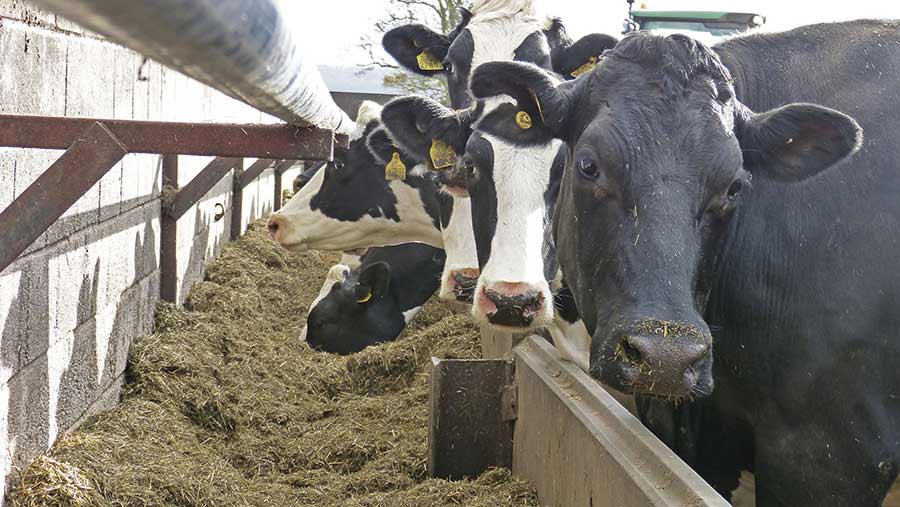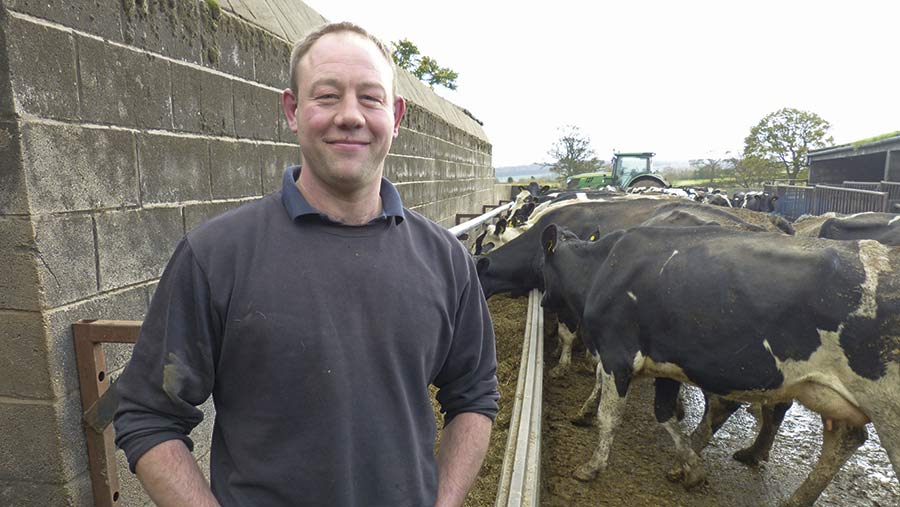How Yorkshire dairy farm has lifted pregnancy rates by 7%
 © Michael Priestley
© Michael Priestley Doubling fresh cow trough space and regular fertility discussions between vet, farmer and breeding experts have lifted pregnancy rates by 7% on a Yorkshire dairy unit.
Pregnancy rates were averaging 18% for the year-round calving herd at Thorncliffe Grange, Emley, when farmer Andrew Parker signed up to Genus RMS.
He quickly saw conception and submission rates lift as Genus technicians oversaw heat detection on daily visits.
This soon took pregnancy rates to 20%, but attention to detail – including adding a fresh cow group – has been the key to steadily lifting this 5% further in the past four years.
See also: Using a transition index helps cut days open on dairy unit
“I started using RMS because I was short of staff and the extra information about the herd proved to be a real bonus,” explains Mr Parker, who needs a level calving pattern for his contract with Buckley’s Dairy.

Andrew Parker
Mr Parker says the data uncovered some problems and resulted in practical suggestions from the Genus team on how to improve fertility.
“We were previously very seasonal in our conception rates. We had periods of very good pregnancy rates and then periods at 13-15%,” admits Mr Parker.
“Now I know I need five cows calving each week and if there aren’t at least 10 cows in calf at each pregnancy diagnosis, we have gone astray.”
These targets are now used to highlight problems, he adds.
Some of the fertility success is also down to the fact Mr Parker made a concerted effort to feed cows well despite a milk price drop that saw him receiving 16p/litre in 2016. This kept cows in good condition and ensured they were transitioning well.
Thorncliffe Grange
- 280 Holstein-Friesians giving 8,500-9,000 litres
- 4% butterfat and 3.4% protein
- 364ha in total
- 21ha maize, 22ha beans, 140-150ha of cereal
- Bull calves fed rolled wheat and barley and sold deadweight
- Year-round-calving herd
-
Supplies Medina Dairy
-
Farm requires four full-time staff
-
Herd milked twice a day in a 16:32 Gascoigne parlour
- Cows paddock grazed from April to October
How establishing a fresh cow group has helped
All cows are fed in feed troughs at Thorncliffe Grange, meaning time is saved on pushing up feed. However, competition at the trough was suspected to be holding back some cows, which is why Mr Parker started a fresh cow group and increased trough space.
“The fresh cow group was started five years ago when we started to address trough space in 2015 to lift dry matter intakes [DMIs],” he explains.
Cows enter the fresh cow group after calving and leave once they have reached 21 days in milk (DIM).
Trough space has doubled across the farm, leaving the milking group with 60cm of trough space, and transition cows (dry and fresh) with 75cm.
The results have been pleasing, according to Huw Lloyd, Genus ABS technical services director, who says the farm’s average days to first AI is 61, with a voluntary waiting period of 42 days in milk for the past four years.
“Maximising DMI through improved access to a balanced diet can reduce the risk of metabolic disease,” explains Dr Lloyd. “Importantly, this allows cows to meet lactation metabolic demands and has positive reproductive benefits such as improving first AI conception rate.”
Breeding choice
Thorncliffe Grange aims to breed durable cows, selecting bulls on longevity, somatic cell count, daughter fertility and also production, averaging +£633 profitable lifetime index (PLI) for the past 12 months.
“Good feet and legs are important too,” explains Mr Parker. “We are not trying to breed anything too extreme, just an easy-to-manage Holstein.”
About 80% of artificial inseminations are now genomic, with the main herd receiving four conventional semen services to Holstein bulls, after which British Blue straws are used.
Up until recently, three black and white services before beef straws was the approach, but this was changed to four following an unfortunate Neospora outbreak, which resulted in the farm needing more heifers.
Meanwhile, heifers are transported to a nearby rearing site at five to six months old and are housed in buildings with self-locking yokes. After two inseminations to sexed semen they run with an easy-calving Limousin bull before returning to Thorncliffe Grange to calve down at 23-25 months old.
Breeding protocol
Any cows that have been missed or not seen bulling are inspected to see if a corpus luteum is present.
Estrumate and an ov-synch programme is used after a 50-day voluntary waiting period, which is overseen by Donladson’s Vets during fortnightly visits.
Close eye on ketosis
Any at-risk fresh cows (metritis, endometritis, low BCS) have bloods checked for ketone levels.
Subclinical ketosis cases get a three-day propylene glycol treatment, while clinical cases get five days of treatment. This routine was adopted after a run of ten sets of twins in eight weeks, which put pressure on transition health.
|
Days post calving |
Ketone test result: subclinical |
Ketone test result: clinical |
|
<21 days |
0.9-1.4mmol/litre (three days of treatment) |
1.4mmol/litre + (five days of treatment) |
|
>21 days |
0.5-0.9mmol/litre (three days of treatment) |
0.9mmol/litre+ (five days of treatment) |
Generally, transition cow problems are fairly minimal, with metritis cases at around 1-2%. In two years on the farm, vet Matt Smith has only seen a couple of LDAs and milk fever has been no issue.
